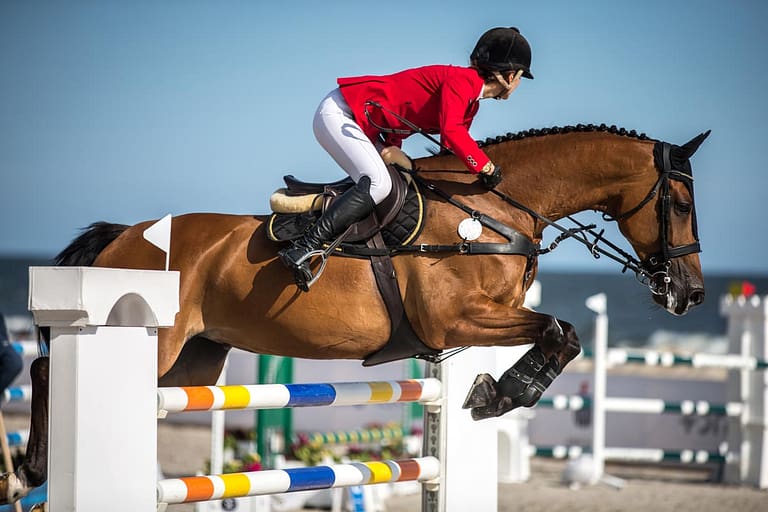What is Equestrian? Authentic Elegance for Horses and Riders
What is Equestrian? A lovely and tough sport. It shows the amazing bond between horse and rider. It’s about elegance, athleticism, and the bond. It forms when humans and horses work together.

The History of Equestrian Sports
Equestrian sports have a rich history dating back centuries. In ancient times, horses were used for transportation, warfare, and entertainment. Over time, riding evolved into a sport of its own. The modern Olympics have had equestrian events since 1912. They include disciplines like dressage, show jumping, and eventing.
Equestrian Disciplines: Dressage, Jumping, Eventing
There are many different equestrian disciplines, each with its own unique challenges:
- Dressage is often described as “horse ballet.” Horse and rider perform precise movements set to music, showcasing grace and obedience.
- In show jumping, horse and rider navigate a course of obstacles, aiming for a clear round in the fastest time. It’s a thrilling display of agility and bravery.
- Eventing is the triathlon of the equestrian world. It combines dressage, cross-country jumping, and stadium jumping. The event lasts for three days.
Other disciplines include horse racing, combined driving, endurance, reining, and vaulting. There’s something for every equestrian enthusiast!
The Unique Bond Between Horse and Rider
Equestrian sports are about the amazing bond between horse and rider. It’s a partnership built on trust, communication, and mutual respect. Riders must learn good horsemanship. They do this by mastering subtle aids, like using their seat, legs, and reins to talk to their horse.
Riders build the bond through many hours of training. They train on the ground and in the saddle. Riders work closely with their horses. They do this to improve their riding technique and their horses’ gaits and movements. They also perfect challenging elements like flying changes, half-halts, and pirouettes.
Equestrian Equipment: Saddles, Bridles, and More
Riding sports need lots of special gear. It keeps both the horse and rider safe and performing well. This includes:
- Saddles and bridles designed for each specific discipline
- Protective gear like helmets, body protectors, and boots
- Grooming tools to keep horses clean and comfortable
- Tack like girths, stirrup leathers, and martingales
It’s important that all equipment fits well and is used correctly to avoid discomfort or injury.
Training and Preparing for Equestrian Events
Success in equestrian sports requires a huge amount of preparation and hard work. Horses need daily care, exercise, and training to stay fit and healthy. This includes:
- Regular farrier visits to maintain healthy hooves
- Careful attention to nutrition and feeding
- Veterinary care to prevent and treat any health issues
- Stable management to ensure a safe and comfortable living environment
Riders must also commit to their own fitness and skill development. They may work with instructors and trainers to improve their technique. They also prepare for competitions.
The Role of Horses in Equestrian Sports
Horses are the real stars of equestrian sports. These incredible athletes have been bred and trained for generations. They were bred to excel in various disciplines. Different breeds and types of horses are suited for different sports. Jumpers are powerful warmbloods and endurance mounts are elegant Arabians.
When picking a horse for a discipline, consider its shape, mood, and family. A bloodstock agent may assist in finding the perfect equine partner.
Equestrian at the Olympic Games
Equestrian sports have been a fixture at the Olympic Games for over a century. Currently, the Olympic disciplines are:
- Dressage
- Eventing
- Show Jumping
Competition is fierce. Top riders from around the globe vie for individual and team medals. Judges score each performance based on set criteria. The scores determine the final standings.
Famous Equestrian Athletes and Their Steeds
Throughout history, many iconic equestrian partnerships have captured fans’ hearts. A few famous examples:
Charlotte Dujardin and Valegro were a British dressage duo. They dominated the sport for years. They won many Olympic and World Equestrian Games titles.
Ian Millar is a Canadian show jumper. He holds the record for the most Olympic appearances by an athlete in any sport. He competed in 10 different Games!
Mark Todd is a legendary New Zealand eventer. He won back-to-back individual Olympic gold medals in 1984 and 1988.
These riders and their amazing horses have inspired generations of equestrians worldwide.
The Future of Equestrian: Trends and Innovations
Equestrian sports are changing. Many exciting trends and innovations are shaping their future:
- Advances in equine health and medicine, from regenerative therapies to high-tech diagnostic tools
- Improved footing and arena surfaces for enhanced horse safety and performance
- Para-dressage has grown. It allows riders with disabilities to compete at the highest levels.
- An increased focus on horse welfare and sustainable practices throughout the industry
Equestrian: A Sport for All Ages and Skill Levels
One of the best things about equestrian sports is that they offer something for everyone. You may be a beginner learning to ride or a seasoned competitor. There are opportunities to get involved. You can enjoy all the benefits of working with horses.
It offers something for every rider. There’s casual trail riding and intense cross-country gallops. There’s also elegant dressage freestyles and high-speed barrel racing.
It’s a sport that can be enjoyed for a lifetime, with many riders competing well into their golden years.
The Thrill and Challenge of Equestrian Competition
For those who crave the excitement of competition, equestrian sports deliver in spades. Nothing is quite like the adrenaline rush of galloping toward a huge oxer. Nor is anything like the quiet joy of nailing a perfect piaffe.
But with the thrill comes the challenge. Equestrian sports demand huge dedication, hard work, and resilience. They demand it from both horse and rider. It’s a test of skill and toughness. It’s also a display of partnership.

